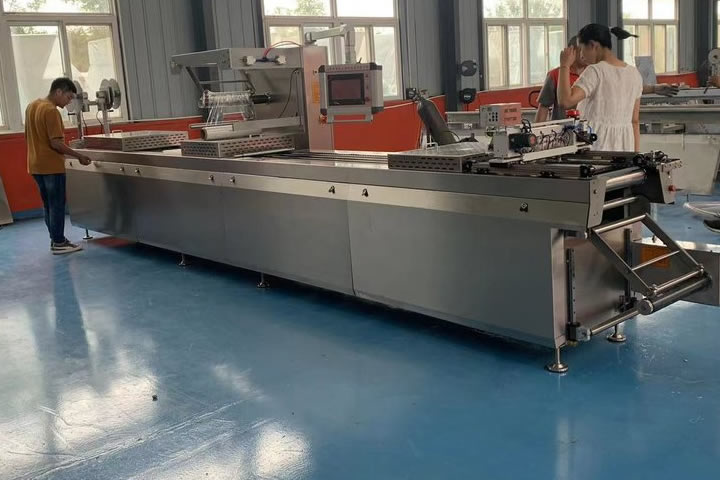Last autumn, when Lao Chen, a seafood processing factory in Jiaodong Peninsula, found us, his brows were furrowed so much that he could hold the delivery note: "The live broadcast room is selling well, but the frozen sea cucumbers are always thawed when shipped to the south, and negative reviews are flying like snowflakes." Three months later, I saw him again. The roaring frozen vacuum packaging machine in the workshop was swallowing and spitting out silver gift boxes. Lao Chen held up his mobile phone to live broadcast the sealing process, and his voice was loud enough to cover the sound of the machine: "My friends, watch it! This vacuum-packed sea cucumber dumpling filling is still fresh after being frozen at minus 18¡æ for half a year!"

When we first walked into Lao Chen's processing workshop, the returned products piled up in the cold storage stung us - the thawed instant abalone oozed juice, and the expensive sea cucumbers stuck together. The vacuum extraction efficiency of traditional frozen packaging machines is low, and the residual air is like a hidden saboteurs, quietly corroding the deliciousness. We adjusted the plan overnight and added a two-stage vacuum pump to the frozen vacuum packaging machine, just like putting on two layers of protective clothing for seafood products: first quickly extract large pieces of air, and then carefully remove trace oxygen molecules. On the day of the test, when the first box of frozen shrimps that were pumped into amber shape was perfectly formed, applause like the sea breeze rang out in the workshop.
The "last mile" problem that seafood e-commerce is most troublesome for is precisely testing the real skills of the frozen vacuum packaging machine. We equipped the equipment with an intelligent temperature control system, so that vacuum sealing and rapid freezing are as tacit as a duet. The quality control manager of a salmon processing plant in Dalian conducted a comparative test: after 48 hours of transportation, the surface of the fish pieces in ordinary frozen packaging has been frosted, while the fish steaks processed by the frozen vacuum packaging machine still maintain an orange-pink luster. He joked: "This machine should be renamed the 'Seafood Time Machine', which can deliver the freshness of the sea directly to the table."
Last month, when we visited the lobster processing plant in Jiangsu, the factory director took us to see the "comparative experimental area" in the cold storage. On the left is the traditionally packaged lobster tail, which is wrapped in ice like armor; on the right is the product processed by the frozen vacuum packaging machine, and the crystal shrimp meat can be seen through the packaging bag. "The vacuum is clean, the ice crystal structure is more delicate, and the taste after thawing is close to freshly caught." Technician Xiao Zhang picked up the shrimp tail with tweezers and observed, "Your wavy heat seal design is really amazing. After three days of bumpy cold chain transportation, the sealing line did not crack."
With the outbreak of fresh community group buying, we realized that the frozen vacuum packaging machine cannot just be a "lone warrior". In the whole factory plan built for a hot pot ingredient brand this spring, the equipment, spiral precooler, and metal detector form an intelligent assembly line. After the lamb rolls from Inner Mongolia are frozen at minus 35¡æ, they are directly put into the frozen vacuum packaging machine for packaging, and the whole process takes no more than 15 minutes. During the acceptance, the customer joked: "This production line is like a 'frozen ID card' for fresh meat, which can be traced from the grassland to the hot pot restaurant."
What makes us most proud is not the technical parameters, but the special "order" received last month. A food factory in a forest area in Heilongjiang suddenly had equipment failure, and hundreds of tons of wild blueberries to be packaged were stored in the warehouse. The after-sales team drove for 8 hours in the snowstorm to arrive. In the workshop at minus 25¡æ, engineer Lao Li wrapped in a military coat debugged the frozen vacuum packaging machine until the early morning. When the first bag of blueberries was vacuum sealed, the factory director shook our hands and said: "This machine not only saves the fruit, but also the hope of the people in the mountains for a year."
If you are also worried about the transportation loss of fresh products, or want to let local specialties go beyond regional limitations, you might as well take a look at these freezing vacuum packaging machines in our workshop. From scallops from the Bohai Bay to yak beef from the Qinghai-Tibet Plateau, from durian meat from tropical orchards to ginseng from Changbai Mountain, we believe that true fresh-keeping technology should allow consumers thousands of miles away to taste the fresh flavor of fruits that have just left the branches and come out of the sea.

